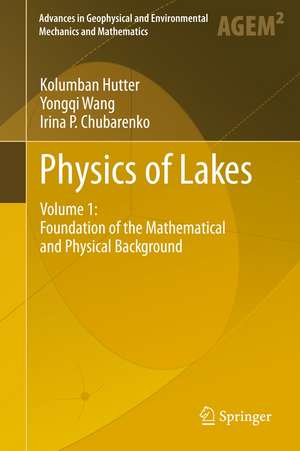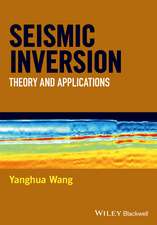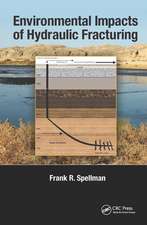Physics of Lakes: Volume 1: Foundation of the Mathematical and Physical Background: Advances in Geophysical and Environmental Mechanics and Mathematics
Autor Kolumban Hutter, Yongqi Wang, Irina P. Chubarenkoen Limba Engleză Paperback – 2 ian 2013
| Toate formatele și edițiile | Preț | Express |
|---|---|---|
| Paperback (3) | 953.35 lei 6-8 săpt. | |
| Springer Berlin, Heidelberg – 2 ian 2013 | 953.35 lei 6-8 săpt. | |
| Springer International Publishing – 3 sep 2016 | 962.18 lei 6-8 săpt. | |
| Springer Berlin, Heidelberg – 7 oct 2014 | 1563.24 lei 6-8 săpt. | |
| Hardback (3) | 957.75 lei 6-8 săpt. | |
| Springer Berlin, Heidelberg – 11 noi 2010 | 957.75 lei 6-8 săpt. | |
| Springer International Publishing – 7 apr 2014 | 965.52 lei 6-8 săpt. | |
| Springer Berlin, Heidelberg – 29 iul 2011 | 1565.29 lei 6-8 săpt. |
Din seria Advances in Geophysical and Environmental Mechanics and Mathematics
- 18%
 Preț: 1850.21 lei
Preț: 1850.21 lei - 24%
 Preț: 797.78 lei
Preț: 797.78 lei - 15%
 Preț: 643.84 lei
Preț: 643.84 lei - 15%
 Preț: 642.51 lei
Preț: 642.51 lei - 18%
 Preț: 1679.57 lei
Preț: 1679.57 lei - 15%
 Preț: 644.18 lei
Preț: 644.18 lei - 18%
 Preț: 1222.31 lei
Preț: 1222.31 lei - 18%
 Preț: 940.25 lei
Preț: 940.25 lei - 18%
 Preț: 947.67 lei
Preț: 947.67 lei - 18%
 Preț: 939.12 lei
Preț: 939.12 lei - 18%
 Preț: 1217.41 lei
Preț: 1217.41 lei - 15%
 Preț: 639.25 lei
Preț: 639.25 lei - 15%
 Preț: 642.03 lei
Preț: 642.03 lei - 15%
 Preț: 651.02 lei
Preț: 651.02 lei - 18%
 Preț: 963.91 lei
Preț: 963.91 lei - 18%
 Preț: 967.88 lei
Preț: 967.88 lei - 15%
 Preț: 650.69 lei
Preț: 650.69 lei - 24%
 Preț: 542.10 lei
Preț: 542.10 lei - 18%
 Preț: 1242.83 lei
Preț: 1242.83 lei - 18%
 Preț: 1220.12 lei
Preț: 1220.12 lei - 15%
 Preț: 637.46 lei
Preț: 637.46 lei
Preț: 953.35 lei
Preț vechi: 1162.61 lei
-18% Nou
Puncte Express: 1430
Preț estimativ în valută:
182.42€ • 190.97$ • 150.94£
182.42€ • 190.97$ • 150.94£
Carte tipărită la comandă
Livrare economică 05-19 aprilie
Preluare comenzi: 021 569.72.76
Specificații
ISBN-13: 9783642265976
ISBN-10: 3642265979
Pagini: 484
Ilustrații: XLVII, 434 p.
Dimensiuni: 155 x 235 x 25 mm
Greutate: 0.67 kg
Ediția:2011
Editura: Springer Berlin, Heidelberg
Colecția Springer
Seria Advances in Geophysical and Environmental Mechanics and Mathematics
Locul publicării:Berlin, Heidelberg, Germany
ISBN-10: 3642265979
Pagini: 484
Ilustrații: XLVII, 434 p.
Dimensiuni: 155 x 235 x 25 mm
Greutate: 0.67 kg
Ediția:2011
Editura: Springer Berlin, Heidelberg
Colecția Springer
Seria Advances in Geophysical and Environmental Mechanics and Mathematics
Locul publicării:Berlin, Heidelberg, Germany
Public țintă
ResearchCuprins
Mathematical Prerequisites.- A Brief Review of the Basic Thermomechanical Laws of Classical Physics.- Fundamental Equations of Lake Hydrodynamics.- Conservation of Angular Momentum - Vorticity.- Turbulence Modelling.- Introduction to Linear Waves.- The Role of the Distribution of Mass within Water Bodies on Earth.- Vertical Structure of Wind-induced Currents in Homogenous and Stratified Waters.- Phenomenological Coefficients of Water.
Recenzii
From the reviews:
“The book offers a broad, self-contained introduction to the physics of lakes and will be an invaluable reference for all those with an active interest in geophysical mechanics research and teaching.” (Felix Kaplanski, Zentralblatt MATH, Vol. 1207, 2011)
“The book offers a broad, self-contained introduction to the physics of lakes and will be an invaluable reference for all those with an active interest in geophysical mechanics research and teaching.” (Felix Kaplanski, Zentralblatt MATH, Vol. 1207, 2011)
Caracteristici
Works from simple to complex model descriptions gradually building a growing understanding of the physical dynamics of lakes using only basic calculus worked to the level required for application to field theory The classical physical laws of mass balance, momentum, angular momentum and energy are also carefully presented at a beginners level of knowledge Deals with the formulation of the mathematical and physical background
Textul de pe ultima copertă
The ongoing thread in this volume of Physics of Lakes is the presentation of different methods of investigation for processes taking place in real lakes with a view to understanding lakes as components of the geophysical environment. It is divided into three parts. Part I is devoted to numerical modeling techniques and demonstrates that (i) wind-induced currents in depth-integrated models can only adequately predict current fields for extremely shallow lakes, and (ii) that classical multi-layered simulation models can only adequately reproduce current and temperature distributions when the lake is directly subjected to wind, but not the post-wind oscillating response. This makes shock capturing discretization techniques and Mellor-Yamada turbulence closure schemes necessary, as well as extremely high grid resolution to reduce the excessive numerical diffusion. Part II is devoted to the presentation of principles of observation and laboratory experimental procedures. It details the principles of operation for current, temperature, conductivity and other sensors applied in the field. It also discusses the advantages and limitations of common measuring methods like registration from stationary or drifting buoys, sounding and profiling from a boat, etc. Questions of data accuracy, quality, and reliability are also addressed. The use of laboratory experiments on a rotating platform is based on an exposition of dimensional analysis and model theory and illustrated using Lake Constance as an example. Part III gives an account of the dynamics of lake water as a particle-laden fluid, which, coupled with the transport of the bottom sediments, leads to morphodynamic changes of the bathymetry in estuarine and possibly whole lake regions. An elegant spatially one-dimensional theory makes it possible to derive analytic solutions of deltaic formations which are corroborated by laboratory experiments. A full three-dimensional description of the evolution of the alluvial bathymetryunder prescribed tributary sediment input indicates a potential subject for future research.




















